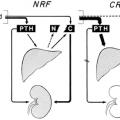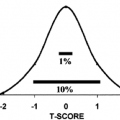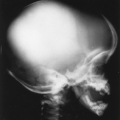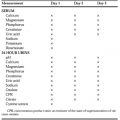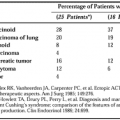OSTEOGENESIS IMPERFECTA
Osteogenesis imperfecta (OI; brittle-bone disease) is characterized by osteopenia with recurrent fractures and deformity, dental disease, and premature hearing loss67 (see Chap. 70 and Chap. 189). Clinical severity is extremely variable, ranging from still-birth to deafness or fracture late in adult life. The pathogenesis involves quantitative and often qualitative abnormalities in the biosynthesis of type I collagen, the most abundant protein in bone. Connective tissue in ligaments, skin, sclerae, and dentin is also affected, because type I collagen is normally present in these structures as well. Classification into several clinical types has been useful, but the understanding of OI has been greatly improved by the identification of > 250 distinct mutations in the genes that encode the α1 and α2 procollagen chains which inter-twine to form the type I collagen heterotrimer2,3,68 (see Chap. 189).
Patients with OI may also be troubled by ligamentous laxity causing joint hypermobility, excessive diaphoresis, and bruising. They are predisposed to pulmonary infections if they have severe thoracic deformity from vertebral collapses and kyphoscoliosis. Mitral valve clicks are common, but significant cardiac disease is unusual. Hearing loss affects approximately half of patients younger than 30 years of age and nearly all who are older. Deafness may be conductive, sensorineural, or of mixed pathogenesis. The differential diagnosis of multiple fractures in the pediatric population includes the “battered baby” syndrome and congenital indifference to pain. Generalized osteopenia in children may be due to idiopathic juvenile osteoporosis, Cushing disease, or many other disorders.4
The classification scheme of Sillence, which emphasizes the apparent mode of inheritance and severity of the skeletal manifestations of OI, is referenced frequently68 (see Chap. 189); however, essentially all forms of OI are inherited as autosomal dominant disorders.68 Type I OI is associated with blue sclerae (especially obvious in childhood), osteopenia with recurrent fracture but often normal stature, and deafness during early adulthood (30% of cases). Dentinogenesis imperfecta may be absent or present in different kindreds (types IA and IB, respectively). Joint laxity or hernias can also occur. Affected women, who may first present with fractures late in adult life, can be mistakenly thought to have postmenopausal or involutional osteoporosis, and radiographic findings may not distinguish the disorders. Approximately one-third of OI patients represent new mutations.68 Histomorphometric assessment of undecalcified specimens of bone reveal an increased number of cortical osteocytes in some patients.68a
Stay updated, free articles. Join our Telegram channel

Full access? Get Clinical Tree


